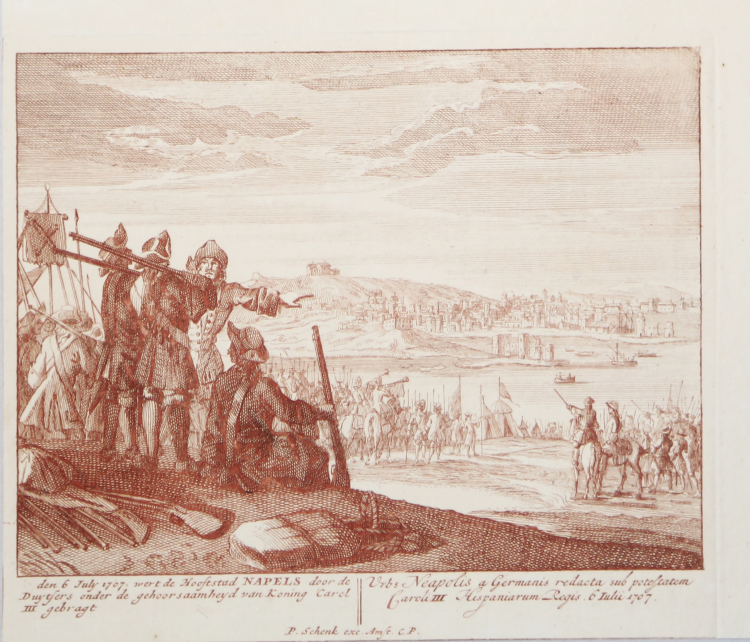



| Reference: | S22024 |
| Author | Pieter SCHENK |
| Year: | 1712 |
| Zone: | Naples |
| Printed: | Amsterdam |
| Measures: | 190 x 160 mm |


| Reference: | S22024 |
| Author | Pieter SCHENK |
| Year: | 1712 |
| Zone: | Naples |
| Printed: | Amsterdam |
| Measures: | 190 x 160 mm |
Plate taken from "THEATRUM BELLICUM, INCIPIENS A CAROLO II. Hispaniarum Rege ad CAROLUM III CONTINENSQUE Novem Historicas figuras, in magna charta expressas, praecipuarum, obsidionum tam Mari quam Terra, praecipuorum munimentorum ad Rhenum, Mosam, Mosellam, uti [et] in Hispania [et] Italia sitorum. Addita est brevis descriptio lingua Latina [et] Belgica. Hujus modi Tabula centinens novem figuras praecipuarum rerum gestarum quotannis renovabitur, oftendens publica negotia Belli [et] Pacis, ut [et] Instrumenta bellica mari [et] terra usurpari solita, quorum auctores sunt Ingeniosi Viri Koehoorn, Vauban, alique, quos fama hac tempestate celebrat", printed in Amsterdam by Pieter Schenk, '1712' [but c.1714-1720].
The "Theatrum Bellicum" is composed by 18 double-page engraved plates, the first 17 divided into 9 small engravings of historical events, and maps, plans or views of towns, fortifications and battles with engraved explanatory captions in Dutch and Latin.
SCHENK'S ICONOGRAPHIC HISTORY OF THE WAR OF THE SPANISH SUCCESSION, augmented and updated with additional plates added after the publication of the first edition of 1706 to describe events up to November 1713, the signing of the early Treaties of Utrecht (including that of 11 April 1713 between England and France), and the death of Frederick I King of Prussia and his succession by Frederick William I.
Pieter SCHENK (1660 - 1718 ca.)
|
Petrus Schenck, or Pieter, or Peter Schenk the Elder (baptized: 26 December 1660 – between 12 August and 17 November 1711 in Leipzig) was a German engraver and cartographer active in Amsterdam and Leipzig. The engraver and map publisher Peter Schenk was born in 1660 in Elberfeld. He moved to Amsterdam in 1675 and became a student of Gerard Valck specializing in mezzotint. Valck was married to Maria Bloteling, the sister of the Amsterdam engraver Abraham Bloteling. In 1687 Schenk married Gerard's sister Agatha Valck. In 1694, together with Valck, he bought some of the copperplates of the artdealer and cartographer Johannes Janssonius. Along with Valck and Bloteling, he produced prints for the London market, though it is not known if he ever went there with them. Until 1700 he lived in the Jordaan, then he moved to Dam Square or to Leipzig, where he opened a shop, selling maps and art. He was a regular visitor to the trade fair Leipziger Messe in Leipzig, where he died. He had three sons who became engravers. His eldest son Peter Schenk the Younger was also a noted cartographer and art dealer who continued his father's shop in Leipzig. His sons Jan and Leonard stayed in Amsterdam and probably continued their father's workshop. His daughter Maria married Leonard Valck, the son of Gerard, who continued Gerard's workshop.
|
Pieter SCHENK (1660 - 1718 ca.)
|
Petrus Schenck, or Pieter, or Peter Schenk the Elder (baptized: 26 December 1660 – between 12 August and 17 November 1711 in Leipzig) was a German engraver and cartographer active in Amsterdam and Leipzig. The engraver and map publisher Peter Schenk was born in 1660 in Elberfeld. He moved to Amsterdam in 1675 and became a student of Gerard Valck specializing in mezzotint. Valck was married to Maria Bloteling, the sister of the Amsterdam engraver Abraham Bloteling. In 1687 Schenk married Gerard's sister Agatha Valck. In 1694, together with Valck, he bought some of the copperplates of the artdealer and cartographer Johannes Janssonius. Along with Valck and Bloteling, he produced prints for the London market, though it is not known if he ever went there with them. Until 1700 he lived in the Jordaan, then he moved to Dam Square or to Leipzig, where he opened a shop, selling maps and art. He was a regular visitor to the trade fair Leipziger Messe in Leipzig, where he died. He had three sons who became engravers. His eldest son Peter Schenk the Younger was also a noted cartographer and art dealer who continued his father's shop in Leipzig. His sons Jan and Leonard stayed in Amsterdam and probably continued their father's workshop. His daughter Maria married Leonard Valck, the son of Gerard, who continued Gerard's workshop.
|